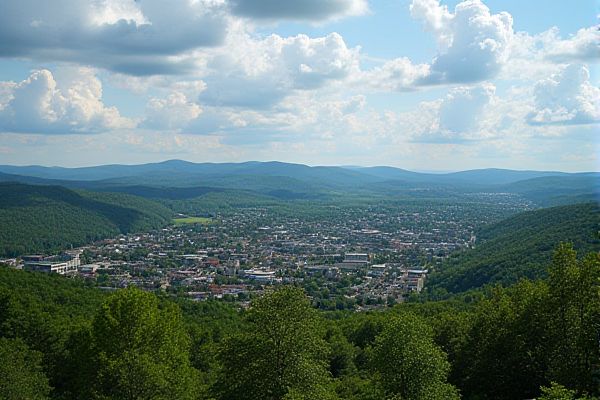
Housing market and best cities to live in Vermont: Burlington - cultural and employment hub. Montpelier - charming capital city. Middlebury - classic college town feel. Housing prices generally rising. High demand in popular areas. Limited inventory in rural regions. Stowe - ski town with luxurious amenities. Vermont's property tax rates. Public transportation options availability. Local amenities influence housing prices.
Burlington - cultural and employment hub.
Burlington, VT, is a vibrant cultural and employment hub with an average home value of $528,388, reflecting a significant increase of 3.2% over the past year, and a highly competitive housing market. The city offers a rich quality of life, a strong business climate, and abundant cultural, artistic, and recreational opportunities, making it one of the best cities to live in Vermont. For more detailed insights, you can explore the Burlington Housing Market which highlights the dynamic nature of real estate in this thriving community.
Montpelier - charming capital city.
Montpelier, Vermont's capital, offers a stable economy, good job numbers, and reasonable housing prices, making it an attractive place for real estate investment. With its rustic charm, top-notch schools, and lively culture, Montpelier provides a unique environment for both families and investors. Despite some challenges, such as limited housing and office spaces, the city continues to thrive, capturing the interest of many. For those considering real estate opportunities, exploring the Best Neighborhoods To Invest In Montpelier reveals promising prospects for a rewarding venture.
Middlebury - classic college town feel.
Middlebury, Vermont, offers a classic college town feel with a highly competitive housing market, characterized by a median home price of $447K, up 11.7% since last year, and homes selling quickly, often with multiple offers and pending in around 16 days. The town is known for its historic architecture, vibrant culture, and relatively affordable housing compared to other cities in the state. For an in-depth analysis and detailed metrics of the local real estate trends, you can visit the Redfin website. Middlebury continues to attract buyers looking for charm and a bustling community atmosphere.
Housing prices generally rising.
Housing prices in Vermont are generally rising, with the median home sale price reaching $455,900 in July 2024, marking a 14.3% year-over-year increase. Homes are spending only 39 days on the market, indicating a competitive seller's market. Cities like Burlington, Montpelier, and Middlebury are among the best places to live, offering a mix of vibrant culture, affordable housing, and a high quality of life. For more insights into the Vermont Real Estate Market, you can explore detailed analyses and reports on the Houzeo Blog.
High demand in popular areas.
The Vermont housing market is characterized by high demand in popular areas, with cities like Burlington, South Burlington, and Essex Junction experiencing competitive markets. Notably, Burlington has a median home price of $509,500 and a very low median days on market (DOM) of 8, indicating a highly competitive seller's market. For more in-depth insights, you can explore the Vermont Housing Market Trends & Forecast, which provides a comprehensive analysis of these trends.
Limited inventory in rural regions.
The Vermont housing market is characterized by limited inventory, particularly in rural regions, with only about 2.25 months of housing inventory available. This scarcity drives intense competition among buyers, thereby favoring sellers due to high demand and tight supply. Despite an increase in housing inventory, Vermont's rural nature and strict environmental regulations continue to restrict new housing development. This creates a competitive market where homes often sell close to or above their list prices, especially in areas like Shelburne and Burlington. For a thorough analysis, the Vermont Real Estate Market Overview highlights key elements shaping these dynamics.
Stowe - ski town with luxurious amenities.
Stowe, Vermont, is a premier ski town known for its luxurious amenities and robust real estate market. Despite challenges from limited inventory, the market has shown resilience with stable sales volume for single-family homes, price appreciation, and high demand for well-priced properties, making it an attractive destination for both primary homeowners and investors. You can find more details on the market's performance and potential opportunities at Stowe Vermont Real Estate.
Vermont's property tax rates.
Vermont is known for having relatively high property tax rates, which can influence buying decisions and impact the overall cost of homeownership. Although these taxes contribute to public services and infrastructure that support property values, understanding these factors is crucial for any prospective buyers. For more detailed insights into this subject, visit the Vermont Real Estate Market Overview for comprehensive information.
Public transportation options availability.
Vermont's housing market, though facing a shortage with a need for more homes, is characterized by stable home values and low unemployment. For public transportation, cities like Burlington, South Burlington, and surrounding areas are well-served by Green Mountain Transit (GMT), which offers extensive public transportation services including fixed routes, commuter routes, and specialized services for seniors and the disabled. For more insights into the housing dynamics of the region, please visit Vermont's Housing Market for detailed information and analysis.
Local amenities influence housing prices.
The housing market in Vermont is notably shaped by the array of local amenities that the state offers. In cities such as Burlington and Montpelier, the vibrant downtown areas, which provide easy access to education and picturesque landscapes, attract many potential buyers. The appeal of Vermont extends beyond these cities, as residents are drawn to the availability of historic homes, modern apartments, and cultural venues. The presence of outdoor trails and educational institutions significantly impacts the cost of living. Stable home values, low unemployment rates, and green living options further enhance Vermont's attractiveness. For those interested in a deeper analysis of the state's housing market, Vermont Real Estate Market Predictions for 2024 highlights how these factors contribute to the overall health and strength of the market. As a result, cities like Middlebury and Shelburne, known for their vibrant arts scenes and historic architecture, continue to draw diverse residents, affecting local housing prices and desirability.
